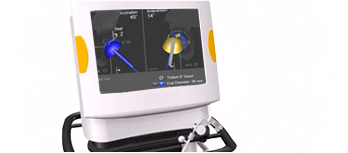Femoral or Tibial Osteotomy
Indication and Procedure Description
This procedure is indicated as the treatment of early osteoarthritis in those patients who are relatively young and active. The aim of the procedure is to correct mal-alignment of the leg where it has become either excessively bowed or knock-kneed due to osteoarthritis. An osteotomy is where the bone is cut, so that the leg can be straightened into a more normal position. The osteotomy is then secured with plate and screws to maintain the correction. This procedure is more commonly performed for patients who are bow-legged, where the medial (inner) part of the knee is involved in osteoarthritis. This procedure is called a medial opening wedge osteotomy and in it, the knee is corrected to a slightly knock-kneed position, therefore shifting the weight through the preserved lateral (outer) part of the knee. Less commonly, it is performed on knock-kneed patients where the osteotomy is performed through the lateral part of the femur and the leg is corrected to a straight position, therefore the weight bearing will be shifted to the preserved medial side.
The purpose of the procedure is to allow young people to remain active without the concerns of wearing out a knee replacement. The osteotomy will slow down the wear of the knee and buy time for the knee and delay a knee replacement.
Preparation for Surgery
Prior to surgery, the patient will have X-rays of both knees to determine the amount of correction that will be required. This can be calculated from the X-rays and will also be fine-tuned intra-operatively.
Hospital Stay
On the day of surgery, the patient will have his/her leg marked. General
anesthetic is usually required and is supplemented by a femoral nerve block which will control the pain post-surgery. After the surgery, the leg will be placed in a straight knee brace which will be removed for exercises by the physiotherapist on the first day after surgery. The larger bandages will also be removed to allow movement. A drain will have been placed in the knee during surgery and this will be removed on the first day following the surgery. The patient will begin
mobilizing on day 1 following the surgery, with the aid of the physiotherapist. The patient will be allowed to weight bear as tolerated through the leg. Crutches will be required for six weeks. This allows sufficient time for the osteotomy to heal. Most patients are able to go home two to three days following surgery. Upon discharge, the patient will be seen again within the first two weeks, to assess the wound. A further appointment will be made for six weeks, three months and one year following the surgery. Further X-Rays will be obtained on each occasion.
Post Operative Care
A knee brace will be required until the patient can comfortably straight leg raise which will occur within the first two weeks following surgery. Once this has been achieved, the brace will no longer be required. However the brace will be removed by the physiotherapist for the initial exercises.
Weight Bearing
Weight bearing will be as tolerated for the first six weeks with the aid of crutches. After six weeks, if X-rays show that healing is satisfactory, the use of crutches can be discontinued.
Exercises
Physiotherapy is begun early. This is initially directed at quadriceps and hamstring exercises.
Range of motion is slowly built up over the period of the first two to four weeks and full movement will be achieved within that time.
As the patient progresses with physiotherapy, functional exercises will begin with the aim of fast walking by three months, and running and return to sporting activities after six months.
Return to Work
Return to work for those patients who do desk based work is approximately two to four weeks, and for those patients who do manual work, the time for return to work is up to three months. |















